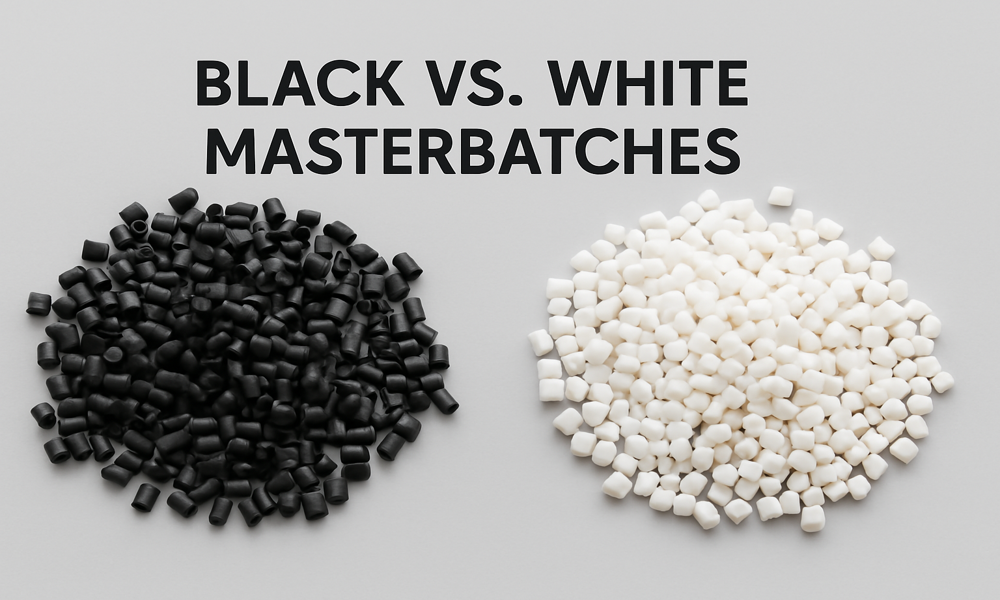Black vs White Masterbatches Which One is Right for Your Application
Black vs. White Masterbatches – Which One is Right for Your Application?
In the world of plastics manufacturing, masterbatches play a crucial role in adding color and other properties to polymer products. Among the most widely used masterbatches are black and white variants, which are essential in various industries ranging from packaging to automotive. But how do you decide which one is right for your application? In this article, we will compare black and white masterbatches, their applications, advantages, and help you make an informed decision on which to choose for your specific needs.
What Are Masterbatches?
Before diving into the specifics of black and white masterbatches, it's important to understand what masterbatches are. A masterbatch is a concentrated mixture of pigments, additives, or other materials, typically in a carrier resin, used to color or modify the properties of the polymer base in plastic products. The masterbatch is blended with the base resin during the manufacturing process, providing the desired color, effect, or functionality to the final product.
Black Masterbatches
What are Black Masterbatches?
Black masterbatches are typically made using carbon black, a fine black powder derived from fossil fuels. Carbon black is used in a variety of applications due to its excellent properties such as UV stability, thermal conductivity, and enhanced durability. The pigment is combined with a carrier resin to form the masterbatch, which is then blended into the polymer during manufacturing.
Applications of Black Masterbatches
Black masterbatches are used in a wide range of industries due to their versatile propert/ies. Common applications include:
-
Packaging: Black plastic packaging, such as bottles and containers, often uses black masterbatches for aesthetic appeal and UV protection.
-
Automotive: In the automotive industry, black masterbatches are used for dashboard components, trim, and even tires due to their ability to protect against UV degradation and enhance product longevity.
-
Construction: In construction materials like pipes, black masterbatches offer protection from the harmful effects of UV radiation.
-
Consumer Electronics: Components like phone cases, laptop covers, and other plastic parts often benefit from black masterbatches for both aesthetic reasons and functionality.
Advantages of Black Masterbatches
-
UV Protection: Carbon black is a highly effective UV stabilizer, protecting plastics from degradation caused by sunlight.
-
Enhanced Durability: Black masterbatches improve the longevity of products by making them resistant to wear and tear.
-
Aesthetic Appeal: Black is a timeless, classic color that gives products a sleek, modern look.
-
Heat Resistance: The high thermal conductivity of carbon black enhances the heat resistance of plastic products, making them suitable for applications that undergo high temperatures.
White Masterbatches
What are White Masterbatches?
White masterbatches are primarily made from titanium dioxide (TiO₂), a highly effective white pigment known for its brightness, opacity, and UV-resistant properties. The pigment is combined with a carrier resin to create a concentrated masterbatch that can be easily blended with the base polymer to achieve the desired shade of white.
Applications of White Masterbatches
White masterbatches are commonly used in industries that require bright, opaque plastics with excellent finish quality. Common applications include:
-
Packaging: White plastic packaging, particularly for food and beverages, uses white masterbatches to ensure clarity, enhance branding, and maintain product visibility.
-
Consumer Goods: Many consumer products like household appliances, toys, and personal care items are made with white plastics for their clean, fresh appearance.
-
Medical Industry: White masterbatches are often used in medical packaging and equipment where high visibility and non-toxicity are paramount.
-
Textiles: In the textile industry, white masterbatches are used to create bright, consistent colors in fabrics and fibers.
Advantages of White Masterbatches
-
Opacity and Brightness: White masterbatches provide excellent opacity, ensuring that the final product is bright and vibrant. This is essential in applications like packaging and consumer goods.
-
UV Stability: Titanium dioxide not only provides color but also offers superior UV resistance, making white plastics durable in outdoor applications.
-
Food-Grade Applications: Titanium dioxide is commonly used in food and pharmaceutical packaging due to its non-toxic properties and FDA approval for use in certain applications.
-
Heat Reflection: White plastics have the advantage of reflecting heat, making them suitable for products exposed to high temperatures or intense sunlight.
Key Differences Between Black and White Masterbatches
While both black and white masterbatches are essential in modern manufacturing, they serve distinct roles and are used for different purposes. Below are the key differences between black and white masterbatches:
-
Color and Aesthetics: Black masterbatches provide a sleek, modern look, whereas white masterbatches offer a clean, fresh appearance. The choice depends largely on the visual appeal required for the product.
-
UV Protection: Black masterbatches, due to the presence of carbon black, provide excellent UV protection, making them ideal for outdoor applications. White masterbatches also offer UV resistance, though not as effectively as black.
-
Opacity: White masterbatches provide higher opacity, which is important for applications that require a bright or opaque finish. Black masterbatches typically don’t have the same level of opacity, unless combined with specific additives.
-
Heat Reflection and Absorption: White plastics are better at reflecting heat, which is crucial for specific applications like reflective coatings. Black plastics, on the other hand, absorb heat, making them suitable for certain high-temperature applications.
Which One is Right for Your Application?
The decision between black and white masterbatches largely depends on the specific requirements of your application. If you need enhanced UV protection, increased durability, and a sleek, modern aesthetic, black masterbatches are an ideal choice, especially for automotive, packaging, and outdoor applications. On the other hand, if your focus is on achieving bright opacity, non-toxicity for food and medical packaging, or heat reflection, white masterbatches will serve you better.
In some cases, it may be necessary to use both black and white masterbatches in different parts of a single product, particularly in the packaging and consumer goods industries. Custom formulations can also be created to meet specific performance and aesthetic requirements.
Conclusion
Both black and white masterbatches offer unique advantages depending on your application. Black masterbatches are perfect for applications requiring UV protection, durability, and sleek aesthetics, while white masterbatches are ideal for bright, opaque finishes and UV stability. Understanding the specific needs of your product will help you choose the right masterbatch, ensuring optimal performance and visual appeal. Whether you’re in packaging, automotive, construction, or consumer electronics, selecting the right masterbatch will enhance the quality and functionality of your plastic products.


